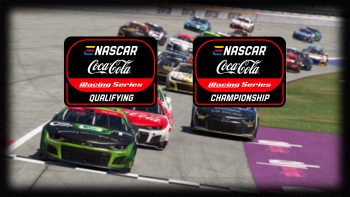
Commodore’s Garage #10 – Track Bar
October 9th, 2016 by Matt Holden
Before moving into initial setup options on our cars and how to go about getting what you need to race, we still need to cover the “bars” in the car. Stock cars typically have a front sway bar and a rear track bar (or Panhard Rod), while road racing cars have a front and rear sway bar. In this article we’ll cover the track bar and the purpose it serves in the car, the sway bar will be covered in the next article. While I try to include a lot of images to show off how the components operate in the car, but the track bar is an incredibly difficult part to see on a car because of its location. Plus, teams often paint the bar black, making it even more difficult to see! Still, I have tried to provide images when possible to point out the bar in real-world cars.
Tracking Straight
In the style of suspension used in a stock car (truck arm, solid rear axle), the rear end design naturally produces left-to-right movement in operation. The entire rear end housing (the part that contains the rear axles and differential) can move left to right in the car as well as up and down under normal operating conditions simply because of how it’s built. It’s simple enough to understand how having the rear tires wander left and right at 180mph would be a bit of a problem, so we have what’s known as the “Track Bar”. One end of the track bar is installed solidly to the left end of the rear end housing (just inside of the left-rear wheel) and the other end of the bar is attached to the frame behind the right-rear wheel, usually on an easily-adjustable slider mechanism. This installation method links the floating rear-end housing to the frame and body of the car, reducing or eliminating side-to-side movement of the housing in the car, and keeping the car driving in a straight line.
To look at the track bar’s mounting system, we’ll look back at the image I used to point out where the roll center is for the rear suspension. While I want to note that this is the track bar in a show car, it still shows off the general configuration that is common today in stock cars. We’re looking at the back of the car, with the bar oriented in the way it would be oriented on a setup sheet in iRacing’s garage. The left end of the track bar (height shown with blue bar) is bolted onto a slotted mounting plate attached to the rear end housing. Each slot on this mounting plate would represent one “adjustment” for this end of the track bar. The right end of the bar (shown with a red bar) is mounted to a sliding adjustment mechanism attached to the bottom of the car’s frame. It’s difficult to see in this image, but the bar itself is attached to a sleeve around a large tube on the right of the image. This sleeve has a screw running through it, and turning this screw (whether by the window bolt or an electronic driver adjuster) will raise or lower this end of the track bar.
Adjusting Overall Height
The track bar can be used primarily in one of two ways: overall height and height difference (also known as “rake”). There is quite a lot of general stuff that goes on with the track bar in terms of how the rear end behaves in the car, how the springs and tires are loaded, and how the car rolls left and right in the corners. All of those are covered by these two simple options though, causing a very simple device to become a very complex and important part of the car.
The overall height of the track bar directly influences the rear suspension’s roll stiffness (covered in article #5, “Roll Stiffness“) by locating the roll center of the rear suspension. For the type of suspension we see in a stock car, the roll center is located around the center of the track bar, regardless of its configuration in the car. So for instance, if we have the track bar set at 8″ high on the left side and 10″ high on the right side, the roll center is located about 9” off the ground (RC location: (Left-side Track Bar height + Right-side Track Bar height)/2). In terms of overall balance of the car, this is the easiest adjustment we can make to the car to cure long-run issues. As we raise the rear roll center, the rear suspension will become stiffer in roll and the left-front/right-rear will be loaded heavier than at a lower setting. Raising the bar in this manner will reduce a long-run swing towards a tight car by evening out loads around the car. Similarly, if we lower the track bar, we’ll reduce a long-run swing towards a loose car.
Where this becomes a more complex problem is in driver feel. If the rear of the car is significantly softer in roll than the front of the car, raising the track bar will typically not be something the driver feels at all initially, but may comment on it later into a run. My own experience with this adjustment has shown that the real effects won’t show up until lap 15-20 at the earliest when the driver may comment that raising the bar freed the car up through the center. On the other hand, lowering the track bar is almost always apparent to the driver immediately, with the driver typically saying that the rear is more secure, or that it has more “side bite”.
Furthermore, it’s important that this adjustment includes zero change in the track bar’s rake. Moving either end of the bar will change where the roll center is located, but adjusting one end without the other will change how the rear end is loaded under lateral forces. If your goal is to change the car’s handling over a long run, and you believe that a roll center change will alleviate some of your handling issues, make sure you move the track bar equally on both ends. If you don’t, and you change the bar rake, you’ll wind up making two adjustments.
Adjusting Rake Angle
Track bar angle adjustment is the most common adjustment we hear about in NASCAR. The left end of the bar is fixed in place once the car is on track, but the right end of the bar can be moved up or down while the car is on track or in the pits through the screw adjustment mentioned earlier. While this does adjust the roll center location (and thus long-run balance) it primarily changes how the bar is loading the rear end of the car.
When the car goes into the corner and has a lateral force applied to it from cornering, the track bar has to exert forces to keep the body and frame from moving over to the right. If the bar is perfectly flat and parallel with the track, it will exert a force in a purely leftward direction to keep the rear end housing from moving. If we run the bar with an angle then the bar will exert a force at an angle, relative to the chassis. This produces both a leftward force and a downward force on the right-rear of the car.
In this image I’ve drawn a simple track bar (black bar) mounted at a large angle for demonstration purposes. In the corners, the car will experience a large lateral force, represented by the purple arrow. This force will try to push the car and its parts to the right, and since the rear end housing is directly connected to the tires, which are stuck to the track, the body of the car will want to rotate to the right, away from the rear end housing. The track bar will take over and pull the body back in line, exerting a force down the bar from the right-side mount to the left-side mount, represented by the red arrow. Since this force acts at an angle, it can be split into a horizontal component and a vertical component. The horizontal component of this force, shown as a blue arrow, is what keeps the housing and body aligned under the lateral G-force generated by the turn. The angle also produces a vertical force, represented by a green arrow in the image above. This vertical force pulls down on the frame, and due to the right-side mount’s location loads the right-rear spring and wheel. If we were to run the right-side lower, or “negative rake”, this would pull up on the right-side of the car and unload the right-rear. Forces such as this vertical component are what’s known as jacking forces, or forces that are placed on the tires as a result of suspension component movement, which we’ll cover later.
Other Considerations
In real-world racing, the track bar’s location can tell you a lot about the way things are set up in the rear of the car (and sometimes the front, indirectly). In the days of the Generation 5 “COT” car, we frequently saw the bar very low, an indication that the suspension had a naturally high roll stiffness. For the Gen 6 cars, we see it a little bit higher than back in the COT days. We can link this to the fact that the COT was allowed to use a rear sway bar, thus providing a simple and effective tuning option for the rear roll stiffness. Despite the COT having traditionally soft rear springs (usually less than 1000 lb/in in most cases), the track bar was set low on the car because the sway bar was able to handle the roll stiffness dilemma.
When teams started running the rear bar in a manner that would produce extra skew in the rear end, NASCAR removed the rear bar for the Gen 6 car and we now see higher rear spring rates (in some cases) as well as a higher track bar. Teams have also started painting the bars black, making it harder to see them in the shadows underneath the car. What works on a real car may not work for the sim-racing car simply because you don’t know what else is under the real car. Below is an image of the #48’s car up on jack stands in the garage. Even though the ends of the track bar are visible in the image (the bar itself is black), trying to build a setup based simply on seeing this for your sim-racing vehicle would be difficult, if not impossible. Instead of seeing something like this on TV and trying to replicate it in the sim, think of what may be going on with the springs to result in this track bar configuration, and then start there. Furthermore, those of you who pointed out that the car being on jack stands produced a higher angle than it would on the ground get a high-five.
~~~~~~~~~~~~~~~~~~~~
To keep up to date with The Commodore’s Garage, return to Sim Racing News every Friday afternoon and “Like” our page at https://www.facebook.com/CommodoresGarage
















































